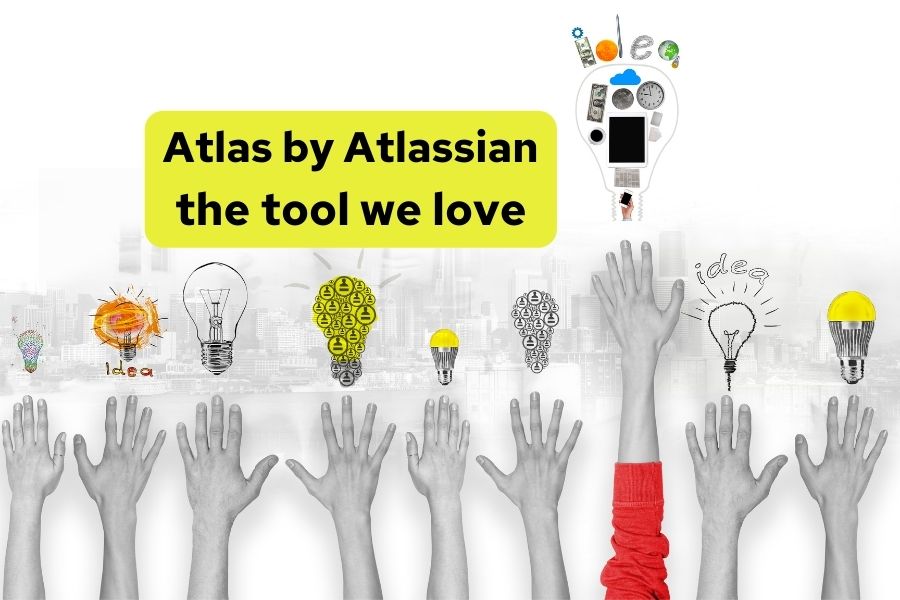The rise of remote and hybrid work has revolutionized the way we operate and emphasized the importance of effective team-to-team communication. In this era where live meetings have become a rarity, improving collaboration and cohesion across different teams is critical. While Agile practices emphasize intra-team communication and customer engagement, cross-team communication is often overlooked and reduced to mere status reporting. This leads to a reliance on tedious and ineffective methods such as redundant online meetings and color-coded spreadsheets that no one bothers to read.
If you need a tool that can provide valuable assistance to your company by helping it stay connected and aligned across its teams and work processes, Atlas by Atlassian might just be the thing you need. In Sipod, we use Atlas to stay informed and updated on relevant projects, goals, and topics.
Whether your team is working synchronously or asynchronously, Atlas is a comprehensive teamwork directory that enables companies to share context, gain alignment, and connect everything across teams. This article will dive deeper into Atlas’s functionalities and how your organization can benefit from its communication framework.
What is Atlas by Atlassian?
Atlas is a tool, a cloud product made by Atlassian, introduced as “the first teamwork directory.” Its goal is to make communication between teams more effective and eliminate the need for unproductive status update meetings. It allows you to post Tweet-sized status updates in 280 characters or less. This way, Atlas encourages you to communicate as effectively as possible and keep your message short. You can finally take the hassle out of status reporting with short and sweet social media-style updates that your team members will love.
Project owners are supposed to post status updates by Friday so that you can open Atlas when you come to the office on Monday, see what’s new, and start your week with all the latest information you may need. Atlas answers three main questions in every company:
- What are we doing?
- Why are we doing it?
- What will success look like?
What are the main features of Atlas by Atlassian?
Teams lie at the heart of Atlas, and everything else revolves around them. Atlas improves your teams’ communication skills and effectiveness. It allows you to celebrate progress and recognize people behind the work by giving them kudos in a fun and more personal way.
Projects show what your team is currently working on more efficiently and transparently. It is where the everyday work happens and status updates get posted, allowing you to stay on top of your team’s progress no matter where you are. You will receive a reminder to post a project update every week.
Goals are company-wide and divided into parent goals and sub-goals. They let you see the bigger picture, and you receive a reminder to post an update once a month.
Topics let you quickly discover relevant topics and keep up with your favorite. Adding tags to your projects and goals allows you to group them by topic and follow them for regular updates. These tags function like hashtags and help you get more out of Atlas, especially as your team grows. You can also follow tags by clicking on them in the sidebar of a project or goal. Doing so will take you to a dedicated feed of updates for that particular tag.
Project updates on Atlas
With Atlas, you can finally say goodbye to noisy updates and hello to a tailored feed of updates that matter to you. You can access the feed with weekly updates on Atlas’ homepage under the Project updates. You will see an overview and all status updates from the projects you are following that are either on track, at risk, or off track, as well as those that are awaiting an update or are completed. On the right-hand side, you will see the projects that you are contributing to, and beneath it, all the new projects that have been created recently, as well as those that have been completed.
The Projects page on Atlas
The Project page overview has a search bar where you can filter your projects by tag, status, goal, team, etc. If you assign deadlines to your projects, you can display them as a list or timeline. Every project has its status and due date and allows you to communicate the context behind the project with your team. You can also follow it or share it with others.
It shows the owner, the contributor, and other team members. You can also link it to the goal it contributes to or other related projects. It is possible to link where the work is tracked and post general helpful links to the team that are always present, and you don’t have to search for them. Moreover, there is also status history, including status and date changes.
The Goals page on Atlas
The Goals page has the same search and filter options as the Projects page. Goals themselves have the same About and Updates sections. The About section should describe why the goal is important. On the right-hand side, you can see the owner, parent goals, sub-goals, and teams currently working on the goal.
The Teams page on Atlas
Teams Page includes a search bar where you can search for people and teams. You can see all the work activity here, including the status of what your team members are working on. Your team kudos will also appear here. At the bottom is a section allowing you to share links with others.
You can post smart links under updates, and they will be shown as cards that can redirect you to Jira. The same goes the other way around. If you are in Jira, you can post a link from Atlas and embed it. That way, you will receive the newest update and stay connected wherever you are. You can even switch from Confluence directly to Atlas.
The Create Page on Atlas
Under the Create page, in addition to creating projects, goals, and teams, you can give kudos and ask questions when you need help from other members. You can add tags for relevant topics to boost the chance of someone answering your question.
Your work on Atlas
Under the Your Work section on the left-hand side menu, you can see all your work from all Atlassian products and easily switch to other products. It is a very handy feature for navigating all Atlassian products.
What are the advantages of Atlas?
Atlas can help companies to connect their work to outcomes and give their teams a sense of purpose by showing them how their projects ladder up to the company’s broader goals. Additionally, with tweet-sized updates, Atlas can help teams stay updated on progress with just enough context without lengthy status meetings.
Atlas also offers universal profiles that provide valuable information on team members, their roles, and their contributions to the organization. The platform’s linked epics enable teams to stay in sync by connecting Atlas Projects to Epics in Jira Software. When we briefly summarize the advantages of Atlas by Atlassian, they are as follows:
- Transparent communication: Everyone can see exactly when and how a project has progressed, always staying connected.
- Review and status updates: Let you save time and nerves with overview pages of teams and projects and status updates so short that everyone will read them.
- Goals: When you define your goals, you can always keep them in mind. It helps you never lose sight of why you are doing what you are doing.
- Get all the details in one place: If your team uses different apps. Atlas can share and receive updates via email, Slack, or Microsoft Teams, so you’ll never miss a beat. And with a single directory for every project in your company, you can easily share live previews of projects and goals where the work is happening.
How does Atlas work?
Atlassian developed a communication system for modern work called the Loop, which serves as the basis for Atlas. Its purpose was to promote healthy and efficient team communication practices. It’s called “the loop” because it keeps teams “in the loop,” making them feel more informed about the company’s activities without feeling overburdened. The Loop has four core values that make healthy and effective teamwork.
#1 Common vocabulary over common tooling
It is vitally important that all teams and departments share a common language to describe their status updates. For example, labeling projects as green indicates that the project is “on track.” Each project’s understanding of being “on track” should mean the same thing. For instance, if one project has no team commitment yet, another is waiting for legal approval, and one is already finished, they should not all be labeled “on track.”
#2 Open up your work in progress
For cross-functional collaboration to be effective, exposing work still in progress is crucial. You can receive valuable feedback early and frequently by sharing your work in progress. Setting expectations with stakeholders regarding the stage of your team’s work is essential to ensure they understand what feedback they can provide.
#3 Curate, don’t automate
Successful cross-functional communication requires curation more than automation. We can quickly become overwhelmed with information with the constant barrage of chat messages, emails, and notifications. Even with advanced technology, the sheer content volume can be too much to handle. Like crafting the perfect tweet, you have to make a deliberate effort to be selective about what, how, and when you share information. By practicing curation, teams can become more effective communicators.
#4 Show that you are paying attention
Effective communication cannot exist if only one party is involved in the exchange. To ensure communication flows smoothly within teams, it’s crucial to demonstrate active listening and engagement.
It can be discouraging to invest significant effort into drafting a status report only to receive no acknowledgment. To prevent this, the Loop involves establishing routines that promote stakeholder engagement and team motivation.
Final words
Atlas by Atlassian can help companies improve communication, streamline processes, and stay connected across their teams and work applications. Its main benefits include effective status reporting through Tweet-sized updates, improving teams’ communication skills and effectiveness, and providing a tailored feed of updates that matter to you.
Atlas also offers the ability to share links with others, receive reminders to post updates, and recognize people behind the work by giving them kudos. Atlas lets organizations share context, gain alignment, and connect everything across teams, leading to increased productivity and better results. If you would like to read more about the tools we love, check out our blog on Camunda.
Tags:





